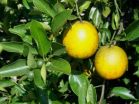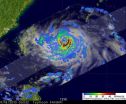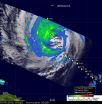(Press-News.org) Hurricane Karl made landfall near Veracruz, Mexico on Friday, Sept. 17 and moved inland over Mexico's rugged terrain, which took the punch out of the storm. As Karl was moving into Mexico, NASA aircraft and NASA satellites were gathering data from this storm that jumped from a tropical storm to a Category 3 hurricane the day before.
Karl had maximum sustained winds of 115 mph when it made landfall on Friday afternoon, Sept. 17. That made Karl a Category three hurricane on the Saffir-Simpson scale, and a major hurricane to boot.
On that day, NASA's Genesis and Rapid Intensification Processes (GRIP) aircraft were flying over Karl and taking readings of the storm's winds, temperature, pressure and more. The DC-8 aircraft was one of the planes that flew into Karl at an altitude of 37,000 feet on the afternoon of Friday, Sept. 17, about 3 hours after Hurricane Karl made landfall in Mexico. The DC-8 aircraft took off from its base in Fort Lauderdale, Fla. All nine instruments installed on the DC-8 collected data during its flight over the storm system, and dropsondes were launched successfully to aid the other instruments in gauging wind profiles and moisture content.
Meanwhile, NASA's WB-57 took off from its base in Houston, Texas and joined the DC-8 for flights over Hurricane Karl in mid-afternoon on Sept. 17. The WB-57 flew higher than the DC-8 aircraft, at an altitude between 56,000 and 58.000 feet. The WB-57 has two instruments aboard to study tropical cyclones: the Advanced Microwave Precipitation Radiometer (AMPR) and the HIRAD (Hurricane Imaging Radiometer). AMPR studies rain cloud systems, but are also useful to studies of various ocean and land surface processes. The HIRAD measures strong ocean surface winds through heavy rain, providing information on both rain rate and wind speed.
For more information on the NASA GRIP Mission, visit: www.nasa.gov/grip.
From its vantage point in space, NASA's Aqua satellite captured a much wider view of Hurricane Karl after it made landfall on Sept. 17. The Moderate Resolution Imaging Spectroradiometer (MODIS) instrument on Aqua captured a visible image at 19:35 UTC (3:35 p.m. EDT) and showed that two-thirds of Karl was already over land.
Karl's heavy rainfall was responsible for inland flooding and evacuations. Reports indicated that almost half a million people were without electricity, and over 20,000 homes were damaged or flooded. Over 40,000 people were evacuated from the municipalities of Jamapa, La Antigua, Medellin de Bravo, Cotaxtla and Actopanm. Reports indicated eight people missing and seven dead from Karl's rampage.
By Saturday morning, Sept. 18, Karl's maximum sustained winds were down to 25 mph. By Sunday, Sept. 19, the National Hurricane Center in Miami, Fla. proclaimed that Karl had dissipated over inland Mexico.
INFORMATION:
NASA satellites and aircraft studied Hurricane Karl before it faded
2010-09-21
ELSE PRESS RELEASES FROM THIS DATE:
Winter drought stress can delay flowering, prevent fruit loss in orange crops
2010-09-21
LAKE ALFRED, FL—Successful mechanical harvesting of perennial fruit crops requires efficient, economical harvesting systems that do not reduce trees' production life or diminish fruit quality. Most of the world's citrus is now harvested manually, but the use of efficient and lower-cost mechanical harvesting techniques is expected to increase in the next few years, especially in the large citrus plantations in Florida and Brazil. The citrus industry is ramping up efforts to extend the harvest season past June, when the following year's crop becomes large enough to be susceptible ...
NASA captures very heavy rain in Typhoon Fanapi and 2 landfalls
2010-09-21
Taiwan experienced a landfall and a soaking from Typhoon Fanapi, and NASA and JAXA's TRMM satellite noted a large area of very heavy rain in the system before it made landfall this weekend. NASA's Aqua and Terra satellites also captured impressive visible images of Fanapi just before the Taiwan landfall, and as it was making landfall in eastern China very early today.
The Tropical Rainfall Measuring Mission satellite known as TRMM captured an image of Typhoon Fanapi's rainfall on Sept. 18 at 0653 UTC (2:53 a.m. EDT) after the typhoon had intensified to 105 knots (~121 ...
Introducing 'Champagne', new disease-resistant fig
2010-09-21
BATON ROUGE, LA—The ancient fig tree, first imported to the United States during the 16th century, thrives in areas of California and the South Atlantic and Gulf Coast areas of the U.S. One of the most popular trees grown in Southern backyards, fig is favored for its versatile fruit and low-maintenance production.
Charles E. Johnson, Ed O'Rourke, and James E. Boudreaux, from the Louisiana State University Agricultural Center in Baton Rouge, introduced a new fig they named "Champagne" in a recent issue of HortScience. According to the report, the new fig performed well ...
NASA's MODIS and AIRS instruments watch Igor changing shape, warming over 3 days
2010-09-21
The Moderate Resolution Imaging Spectroradiometer or MODIS, is an instrument that flies on NASA's Aqua and Terra satellites and provides incredible views of tropical cyclones like Hurricane Igor, from its vantage point in space. Imagery from the MODIS instruments on these two satellites captured from Sept. 18 to 20 showed that powerful Hurricane Igor in the Atlantic Ocean is morphing from a rounded storm to more of a comma-shaped storm.
The MODIS instrument on NASA's Terra satellite captured a visible image of Igor at 11:30 am on Sept. 18, while MODIS in the Aqua satellite ...
Food for thought, er, well...
2010-09-21
Ever wonder why it's such an effort to forget about work while on vacation or to silence that annoying song that's playing over and over in your head?
Mathematicians at Case Western Reserve University may have part of the answer.
They've found that just as thinking burns energy, stopping a thought burns energy - like stopping a truck on a downhill slope.
"Maybe this explains why it is so tiring to relax and think about nothing," said Daniela Calvetti, professor of mathematics, and one of the authors of a new brain study. Their work is published in an advanced online ...
Low-calorie cheesecake? Why we have trouble estimating calories
2010-09-21
When it comes to estimating calorie counts, Americans aren't really on the ball. According to a new study in the Journal of Consumer Research, this may be because of the order in which we encounter the food.
"The sequence in which items are considered often influences our evaluations of these items," writes author Alexander Chernev (Northwestern University). "The focus on sequential estimation is important because many meals are ordered and consumed sequentially rather than at once. Moreover, to control their daily calorie intake, people often estimate not only the amount ...
Santa Fe homeowners weigh in on landscape preferences
2010-09-21
LAS CRUCES, NM—While municipalities may mandate communitywide water conservation measures, individuals—particularly homeowners—can make significant contributions to water conservation in urban environments. Hoping to provide urban planners with more information about how residents' landscape preferences affect municipal water supplies, a team from New Mexico State University surveyed homeowners in Santa Fe about their attitudes toward high desert plants. Rolston St. Hilaire, Dawn M. VanLeeuwen, and Patrick Torres reported on their study of residents' preferences for urban ...
Scientists uncover process enabling toxoplasmosis parasite to survive homelessness
2010-09-21
INDIANAPOLIS — The parasite responsible for toxoplasmosis requires a stress response system that helps it survive the move to infect new cells, Indiana University School of Medicine scientists have reported, a discovery that could lead to new treatments to control the disease.
Parasites such as Toxoplasma gondii invade host cells, replicate and then must exit to find new host cells to invade. Traveling outside their host cell exposes the parasites to environmental stresses that limit how long they can remain viable while searching for new host cells.
The researchers ...
Learning how consumers value products
2010-09-21
Suggesting to consumers that they will use a product frequently can actually reduce their interest in purchasing the product, according to a new study in the Journal of Consumer Research.
"When consumers estimate the value of a durable product, they consider not only the absolute number of times they think they will use the product, but also the number of time they will use the product relative to other consumers," write authors Rebecca W. Hamilton, Rebecca K. Ratner (both University of Maryland, College Park), and Debora Viana Thompson (Georgetown University).
The ...
Could learning self-control be enjoyable?
2010-09-21
When it comes to self-control, consumers in the United States are in trouble. But a new study in the Journal of Consumer Research says there's hope; we just need a little help to see self-regulation as fun.
"Self-control failures depend on whether people see activities involving self-control (e.g., eating in moderate quantities) as an obligation to work or an opportunity to have fun," write authors Juliano Laran (University of Miami) and Chris Janiszewski (University of Florida, Gainesville).
According to the authors, approximately one in five U.S. citizens over the ...





